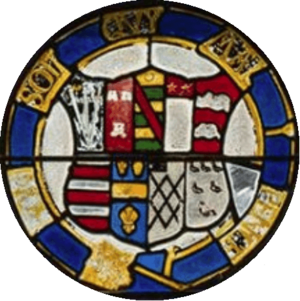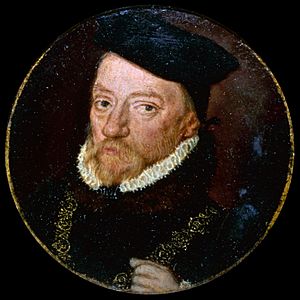William Paulet, 1st Marquess of Winchester facts for kids
Quick facts for kids
The Most Honourable
The Marquess of Winchester
|
|
|---|---|

Paulet, holding the white staff of the office of Lord High Treasurer
|
|
| Lord High Steward for the trial of the Duke of Somerset |
|
| In office October 1551 – November 1551 |
|
| Monarch | Edward VI |
| Chancellor | Richard Rich, 1st Baron Rich |
| Lord Keeper of the Great Seal | |
| In office 1547–1547 |
|
| Monarch | Edward VI |
| Preceded by | Thomas Wriothesley, 1st Earl of Southampton |
| Succeeded by | Richard Rich, 1st Baron Rich |
| Lord High Treasurer | |
| In office 3 February 1550 – 10 March 1572 |
|
| Monarch | Edward VI Mary I Elizabeth I |
| Chancellor |
See
|
| Preceded by | Edward Seymour, 1st Duke of Somerset |
| Succeeded by | William Cecil, 1st Baron Burghley |
| Lord President of the Council | |
| In office January 1546 – 3 February 1550 |
|
| Monarch | Henry VIII Edward VI |
| Chancellor | The Lord Rich |
| Preceded by | Charles Brandon, 1st Duke of Suffolk |
| Succeeded by | John Dudley, 1st Duke of Northumberland |
| Lord Steward of the Household | |
| In office 1544–1551 |
|
| Monarch | Henry VIII Edward VI |
| Preceded by | Charles Brandon, 1st Duke of Suffolk |
| Succeeded by | John Dudley, 1st Duke of Northumberland |
| Lord Chamberlain of the Household | |
| In office 1543–1555 |
|
| Monarch | Henry VIII Edward VI Mary I |
| Preceded by | William Sandys, 1st Baron Sandys |
| Succeeded by | Unknown |
| Treasurer of the Household | |
| In office 1537–1539 |
|
| Monarch | Henry VIII |
| Preceded by | William FitzWilliam, 1st Earl of Southampton |
| Succeeded by | Sir Thomas Cheney |
| Comptroller of the Household | |
| In office 1532–1537 |
|
| Monarch | Henry VIII |
| Preceded by | Sir Henry Guildford |
| Succeeded by | John Russell, 1st Earl of Bedford |
| 1st Lord Lieutenant of Hampshire | |
| In office 1551–1553 |
|
| Monarch | Henry VIII |
| Preceded by | None (office created) |
| Succeeded by | Office vacant |
| High Sheriff of Hampshire | |
| In office 1511–1512 |
|
| Monarch | Henry VIII |
| Preceded by | Richard Sands |
| Succeeded by | Sir William Compton |
| In office 1518–1519 |
|
| Monarch | Henry VIII |
| Preceded by | John Lisley |
| Succeeded by | John Kaleway |
| In office 1522–1523 |
|
| Monarch | Henry VIII |
| Preceded by | William Giffard |
| Succeeded by | Robert Wallop |
| Member of Parliament for Hampshire | |
| In office 1529–1536 Serving with Sir Richard Sandys
|
|
| Monarch | Henry VIII |
| Preceded by | Unknown |
| Succeeded by | Thomas Wriothesley |
| Constituency | Hampshire |
| Personal details | |
| Born |
William Paulet
c.1483 Fisherton Delamere, Wiltshire |
| Died | 10 March 1572 (aged 88–89) Basing House, Basing |
| Resting place | St. Mary's Church, Basing, Hampshire 51°16′17″N 1°02′48″W / 51.271389°N 1.046667°W |
| Nationality | English |
| Spouse | Elizabeth Capel |
| Children |
|
| Parents |
|
| Residences | Basing House, Basing |
| Awards | Knight of the Order of the Garter Several Hereditary peerages |
William Paulet, 1st Marquess of Winchester (born around 1483/1485 – died 10 March 1572) was an important English politician. He held many high-ranking jobs for several kings and queens. He was known for being very adaptable, which helped him stay in power for a long time.
Contents
Early Life and Family Background
William Paulet was the oldest son of Sir John Paulet and Alice Paulet. His family came from a place called Paulet in Somerset, England. They also had a home at Basing House in Hampshire.
There is some debate about exactly when William was born, but it was likely around 1483 or 1485. He might have been born in Fisherton Delamere in Wiltshire.
William's father was a knight who fought in a rebellion in 1497. The Paulet family gained their lands in Hampshire through a marriage many years before. William himself started his career in Hampshire. He was the High Sheriff of Hampshire several times in the early 1500s. A High Sheriff was a local official responsible for law and order. He was made a knight before 1525 and joined the Privy Council (a group of royal advisors) that same year.
William Paulet's Family
William Paulet married Elizabeth Capel, whose father was a Lord Mayor of London. They had eight children together:
- John Paulet, who later became the 2nd Marquess of Winchester
- Thomas
- Chidiock Paulet, who was a governor of Southampton
- Giles
- Alice
- Margaret
- Margery
- Eleanor
A Long Career in Government
William Paulet had a very long and successful career in English government. He served under four different monarchs: Henry VIII, Edward VI, Mary I, and Elizabeth I. This was unusual because the country went through many big changes during this time, especially with religion.
Key Roles and Responsibilities
Paulet held many important positions, including:
- Member of Parliament for Hampshire (1529–1536): This meant he represented his local area in the English Parliament.
- Comptroller of the Household (1532–1537) and Treasurer of the Household (1537–1539): These roles involved managing the royal household's finances and staff.
- Lord Chamberlain of the Household (1543–1545): He was in charge of the royal court and its ceremonies.
- Lord Steward of the Household (1545–1550): Another high-ranking role in the royal household.
- Lord President of the Council (1546–1549): He led the King's most important advisory group, the Privy Council.
- Lord Keeper of the Great Seal (1547): This person was responsible for the Great Seal of England, which was used to make official documents legal.
- Lord High Treasurer (1550–1572): This was one of the most powerful jobs. He was in charge of the country's money and finances for over 20 years.
- Lord High Steward (1551): He oversaw important trials, like the one for the Duke of Somerset.
- Lord Lieutenant of Hampshire (1552, 1553, 1559): This role involved leading the military forces in his home county.
- Speaker of the House of Lords (1558 and 1566): He led discussions in the House of Lords, part of the Parliament.
Rising Through the Ranks
William Paulet's political journey began when he became a Member of Parliament in 1529. He traveled with King Henry VIII to France and became close to important figures like Thomas Wolsey and Thomas Cromwell.
In 1539, he was given the title of Baron St John. He also became the master of the King's Court of Wards and Liveries, which managed the estates of young heirs. In 1543, he was made a Knight of the Garter, a very special honor.
After King Henry VIII died, Paulet continued to be powerful under King Edward VI. He supported the Earl of Warwick (who later became the Duke of Northumberland). Because of this support, in 1550, he was made the Earl of Wiltshire and took over the important job of Lord Treasurer. A year later, he became the Marquess of Winchester.
Adapting to Change
Paulet was famous for his ability to adapt to the changing times, especially during the English Reformation. This was a period when England changed its official religion several times.
- He started as a Catholic but quickly supported King Henry VIII when the King broke away from the Pope. He even gained land from the dissolution of the monasteries (when Henry VIII closed down religious houses).
- Under King Edward VI, who was a Protestant, Paulet became a strong supporter of Protestantism.
- When Catholic Queen Mary I came to power, he quickly changed back to Catholicism and kept his high positions.
- Finally, when Queen Elizabeth I, a Protestant, became queen, he again adapted and supported her middle-ground approach to religion.
People often wondered how he managed to stay in power through so many changes. He once said, "By being a willow, not an oak." This means he was flexible and bent with the wind, instead of being rigid and breaking. Queen Elizabeth I even joked about how much she valued him, saying she would consider marrying him if he were younger!
Later Life and Death
William Paulet remained in his important job as Lord Treasurer until he died. He passed away on 10 March 1572, at a very old age, at his home, Basing House. He had spent time rebuilding and strengthening this house. He is buried in the church at Basing.
Images for kids





